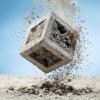
Breaking News
 Mike Rowe appears to be receiving flak for daring to explore the potential dangers of vaccines...
Mike Rowe appears to be receiving flak for daring to explore the potential dangers of vaccines...
 How to Keep Potatoes Fresh for a Year!
How to Keep Potatoes Fresh for a Year!
 A high school student has amazed the global science community with a discovery...
A high school student has amazed the global science community with a discovery...
Top Tech News
 The 6 Best LLM Tools To Run Models Locally
The 6 Best LLM Tools To Run Models Locally
 Testing My First Sodium-Ion Solar Battery
Testing My First Sodium-Ion Solar Battery
 A man once paralyzed from the waist down now stands on his own, not with machines or wires,...
A man once paralyzed from the waist down now stands on his own, not with machines or wires,...
 Review: Thumb-sized thermal camera turns your phone into a smart tool
Review: Thumb-sized thermal camera turns your phone into a smart tool
 Army To Bring Nuclear Microreactors To Its Bases By 2028
Army To Bring Nuclear Microreactors To Its Bases By 2028
 Nissan Says It's On Track For Solid-State Batteries That Double EV Range By 2028
Nissan Says It's On Track For Solid-State Batteries That Double EV Range By 2028
 Carbon based computers that run on iron
Carbon based computers that run on iron
 Russia flies strategic cruise missile propelled by a nuclear engine
Russia flies strategic cruise missile propelled by a nuclear engine
 100% Free AC & Heat from SOLAR! Airspool Mini Split AC from Santan Solar | Unboxing & Install
100% Free AC & Heat from SOLAR! Airspool Mini Split AC from Santan Solar | Unboxing & Install
 Engineers Discovered the Spectacular Secret to Making 17x Stronger Cement
Engineers Discovered the Spectacular Secret to Making 17x Stronger Cement
NASA Assessment Reveals SpaceX Super Heavy Starship Details

Plan for 24 Launches Per Year
The SpaceX goal is to eventually launch Starship/Super Heavy approximately 24 times per year. As Starship/Super Heavy launches gradually increase to 24 launches per year, the number of launches of the Falcon would decrease. The Starship and Super Heavy would exceed the lift capabilities of the Falcon Heavy. Due to the higher lift capability, Starship/Super Heavy could launch more payloads and reduce the overall launch cadence when compared to Falcon 9 and Falcon Heavy. This would increase the cost-effectiveness of the space industry. Starship/Super Heavy missions would include Lunar and Mars destinations, currently not supported by any other space vehicle, increased satellite payload missions, and human spaceflight. Missions could range from tests of the launch vehicle and ship, to cargo delivery. The manifest is incomplete at this time but would evolve as the rocket develops. There could be multiple launches in close succession required to support a single mission (i.e., Lunar Program sending multiple payloads to resupply). Prior to launch, during initial phases of Starship/Super Heavy development, SpaceX would perform rehearsals without propellants on the vehicle (dry) and rehearsals with propellants on the vehicle (wet) to verify full launch readiness. Dry and wet rehearsals were conducted during the development of the Falcon 9. A static fire test of the Super Heavy booster and the Starship would be performed prior to each launch. The static tests would be similar to that currently done for Falcon, with the booster held in place while engines are ignited to simulate the initial stage of launch. The test would be used to assess the performance of the Raptor engines prior to launch.
Landing pad 39A will get new structures and upgrades to existing facilities.

 Wall Street wants to go 24/7
Wall Street wants to go 24/7

